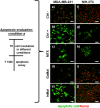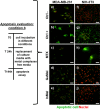Indium/Gallium Maltolate Effects on Human Breast Carcinoma Cells: In Vitro Investigation on Cytotoxicity and Synergism with Mitoxantrone
- PMID: 30023897
- PMCID: PMC6044947
- DOI: 10.1021/acsomega.7b02026
Indium/Gallium Maltolate Effects on Human Breast Carcinoma Cells: In Vitro Investigation on Cytotoxicity and Synergism with Mitoxantrone
Abstract
In this study, we aimed to investigate in vitro whether the synthetized indium maltolate (InMal) and gallium maltolate (GaMal) could exert either a toxic effect toward breast cancer cell line MDA-MB-231 or an agonistic activity with mitoxantrone (MTX) in comparison to fibroblast cell line NIH-3T3. Both GaMal and InMal reduced viability of MDA-MB-231, and at a lesser extent of NIH3-T3, in a dose- and time-dependent mode, the outcome was more effective in comparison to MTX sole exposure. Both GaMal and InMal toxicity was reverted by iron citrate addition on NIH3-T3, not on MDA-MB-231, showing indirectly that gallium and indium's mechanisms of action may include iron targeting. The agonistic activity against MDA-MB-231 survival was shown pretreating with 100 μM InMal for 24 h followed by medium exchange with MTX at 10 ng mL-1 or vice-versa but not with co-incubation of both compounds. In particular, InMal pretreating resulted more protective to MTX subsequent exposure.
Conflict of interest statement
The authors declare no competing financial interest.
Figures





Similar articles
-
Hyaluronan magnetic nanoparticle for mitoxantrone delivery toward CD44-positive cancer cells.Colloids Surf B Biointerfaces. 2018 Nov 1;171:150-158. doi: 10.1016/j.colsurfb.2018.07.025. Epub 2018 Jul 11. Colloids Surf B Biointerfaces. 2018. PMID: 30025377
-
Sequence-dependent administration of 5-fluorouracil maintains methotrexate antineoplastic activity in human estrogen-negative breast cancer and protects against methotrexate cytotoxicity in human bone marrow.Anticancer Res. 2007 Nov-Dec;27(6B):3791-9. Anticancer Res. 2007. PMID: 18225534
-
Synthesis, Characterization, and Study of In Vitro Cytotoxicity of ZnO-Fe3O4 Magnetic Composite Nanoparticles in Human Breast Cancer Cell Line (MDA-MB-231) and Mouse Fibroblast (NIH 3T3).Nanoscale Res Lett. 2016 Dec;11(1):537. doi: 10.1186/s11671-016-1734-9. Epub 2016 Dec 2. Nanoscale Res Lett. 2016. PMID: 27914092 Free PMC article.
-
Gallium and other main group metal compounds as antitumor agents.Met Ions Biol Syst. 2004;42:425-62. Met Ions Biol Syst. 2004. PMID: 15206110 Review.
-
Gallium Complexes as Anticancer Drugs.Met Ions Life Sci. 2018 Feb 5;18:/books/9783110470734/9783110470734-016/9783110470734-016.xml. doi: 10.1515/9783110470734-016. Met Ions Life Sci. 2018. PMID: 29394029 Review.
Cited by
-
Quantitative proteomic reveals gallium maltolate induces an iron-limited stress response and reduced quorum-sensing in Pseudomonas aeruginosa.J Biol Inorg Chem. 2020 Dec;25(8):1153-1165. doi: 10.1007/s00775-020-01831-x. Epub 2020 Oct 30. J Biol Inorg Chem. 2020. PMID: 33125529
-
Gallium maltolate shows synergism with cisplatin and activates nucleolar stress and ferroptosis in human breast carcinoma cells.Cell Oncol (Dordr). 2023 Aug;46(4):1127-1142. doi: 10.1007/s13402-023-00804-x. Epub 2023 Apr 17. Cell Oncol (Dordr). 2023. PMID: 37067747
-
Solution speciation and human serum protein binding of indium(III) complexes of 8-hydroxyquinoline, deferiprone and maltol.J Biol Inorg Chem. 2022 Apr;27(3):315-328. doi: 10.1007/s00775-022-01935-6. Epub 2022 Mar 3. J Biol Inorg Chem. 2022. PMID: 35243522 Free PMC article.
-
New Era in the Treatment of Iron Deficiency Anaemia Using Trimaltol Iron and Other Lipophilic Iron Chelator Complexes: Historical Perspectives of Discovery and Future Applications.Int J Mol Sci. 2021 May 24;22(11):5546. doi: 10.3390/ijms22115546. Int J Mol Sci. 2021. PMID: 34074010 Free PMC article. Review.
-
Deferiprone and Iron-Maltol: Forty Years since Their Discovery and Insights into Their Drug Design, Development, Clinical Use and Future Prospects.Int J Mol Sci. 2023 Mar 4;24(5):4970. doi: 10.3390/ijms24054970. Int J Mol Sci. 2023. PMID: 36902402 Free PMC article. Review.
References
-
- Bernstein L. R. Mechanisms of therapeutic activity for gallium. Pharmacol. Rev. 1998, 50, 665–682. - PubMed
-
- Sampieri F.; Allen A. L.; Alcorn J.; Clark C. R.; Vannucci F. A.; Pusterla N.; Mapes S. M.; Ball K. R.; Dowling P. M.; Thompson J.; et al. Efficacy of gallium maltolate against Lawsonia intracellularis infection in a rabbit model. J. Vet. Pharmacol. Ther. 2014, 37, 571–578. 10.1111/jvp.12132. - DOI - PubMed
-
- Arnold C. E.; Bordin A.; Lawhon S. D.; Libal M. C.; Bernstein L. R.; Cohen N. D. Antimicrobial activity of gallium maltolate against Staphylococcus aureus and methicillin-resistant S. aureus and Staphylococcus pseudintermedius: An in vitro study. Vet. Microbiol. 2012, 155, 389–394. 10.1016/j.vetmic.2011.09.009. - DOI - PubMed
-
- Chitambar C. R.; Purpi D. P.; Woodliff J.; Yang M.; Wereley J. P. Development of gallium compounds for treatment of lymphoma: gallium maltolate, a novel hydroxypyrone gallium compound, induces apoptosis and circumvents lymphoma cell resistance to gallium nitrate. J. Pharmacol. Exp. Ther. 2007, 322, 1228–1236. 10.1124/jpet.107.126342. - DOI - PubMed
LinkOut - more resources
Full Text Sources
Other Literature Sources
Miscellaneous

